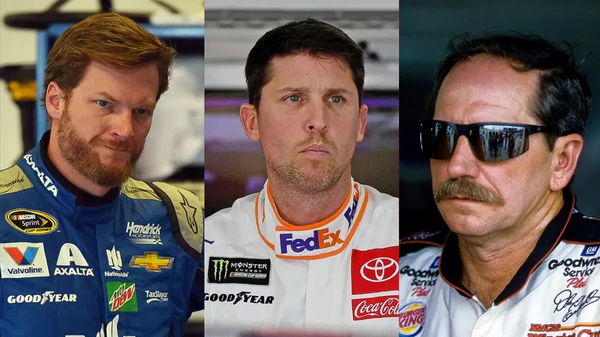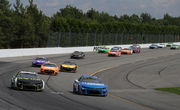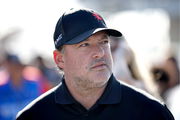

The 2024 Martinsville race will go down in history as one of the most controversial events in NASCAR’s modern era. What started as a typical playoff showdown quickly spiraled into a full-blown scandal, with accusations of race manipulation, strategic blocking, and alliances that left fans and drivers questioning the integrity of the sport. The fallout was immediate: hefty fines, 50-point deductions, and staff suspensions were handed out like speeding tickets at a restrictor-plate race. But the repercussions didn’t stop there. The incident sparked a seismic shift in NASCAR’s rulebook, particularly around superspeedway racing, and left one of the sport’s most outspoken veterans, Denny Hamlin, questioning whether even the greatest superspeedway legends—like Dale Earnhardt Sr. and Dale Earnhardt Jr.—could thrive in today’s era.
Hamlin’s bold take on the state of superspeedway racing has sent shockwaves through the NASCAR community. It’s not a slight against the Earnhardts’ legacy—far from it. Instead, it’s a sobering observation from one of its longest-standing veterans about how the sport has evolved, and, in his view, not necessarily for the better.
ADVERTISEMENT
Article continues below this ad
The Martinsville drama: A turning point for superspeedway racing
The 2024 Martinsville race was supposed to be a high-stakes battle for playoff positioning. Instead, it became a masterclass in chaos. In the closing laps, drivers like Bubba Wallace, Austin Dillon, and Ross Chastain were accused of orchestrating strategic blocks and alliances to manipulate the outcome. NASCAR’s investigation revealed damning radio communications, leading to $100,000 fines, 50-point deductions, and suspensions for key team members.
But the real story wasn’t the penalties—it was the Pandora’s box it opened. NASCAR responded by tightening its rules around race manipulation, particularly on superspeedways. Drafting, once a skill that separated the greats from the good, is now under scrutiny. Drivers are being told who they can and can’t work with, and manufacturers are being held accountable for collusion.
For the uninitiated, drafting is the art of using aerodynamics to your advantage. When a car tucks in behind another, it reduces air resistance, allowing both cars to go faster. It’s a delicate dance of trust and strategy, and it’s been a cornerstone of the massive long superspeedways for decades. Think of it like cycling—riders take turns leading and drafting to conserve energy and maximize speed.
In comes Denny Hamlin, who didn’t hold back on the latest episode of his Actions Detrimental podcast. “Dale Jr. and Dale Earnhardt Sr. would have never survived in today’s superspeedway racing,” he declared. “They wouldn’t have been as successful because of how superspeedway racing happens today. But then to be told when you can and can’t draft with? It’s nonsense, but it’s the world we live in.”
It’s a staggering statement, considering the Earnhardts’ dominance. Dale Sr., the “Intimidator,” was a master of the draft, with 17 superspeedway wins, including a record 10 at Talladega. Dale Jr., his heir apparent, wasn’t far behind, with 10 superspeedway victories of his own, including four straight at Talladega from 2001 to 2003. Their ability to control the draft and dictate the pace was unparalleled.
But Hamlin argues that today’s rules would have handcuffed them. “I appreciate what NASCAR’s trying to do—keep the integrity of the sport,” he said. “But when you’re telling drivers who they can and can’t draft with, it changes everything. It’s not the same game.”

via Imago
Bildnummer: 02467636 Datum: 19.11.2006 Copyright: imago/UPI Photo
Dale Earnhardt Jr. (USA, li.) und Denny Hamlin (USA / beide Chevrolet) im Gespräch – PUBLICATIONxINxGERxSUIxAUTxHUNxONLY (mia2006111912); Junior, Danny, Vdig, quer, close, Overall, Rennoverall, Rennanzug, Sonnenbrille, sunglasses Ford 400 Nascar Nextel Cup Series 2006, US Rennserie, Autorennen Homestead Homestead Miami Speedway Motorsport Herren Einzel USA Gruppenbild Randmotiv Personen
Hamlin knows a thing or two about drafting. He’s used it to his advantage countless times, most notably with BJ McLeod at Atlanta Motor Speedway in 2024. “He was paying me back for the many superspeedway races where I’ve helped him,” Hamlin explained. “It’s a friendship bank. But now, is that considered manipulation? It’s a slippery slope.”
Dale Earnhardt Jr. and Tony Stewart were masters of this. Despite not being teammates, they formed one of the most iconic drafting partnerships in NASCAR history. Their ability to work together at Daytona and Talladega was almost telepathic. Junior would tuck in behind Stewart, or vice versa, and they’d slice through the field like a hot knife through butter. Broadcasters would often point out their comradery and fans loved it. Together, they racked up multiple top-three finishes, proving that drafting was about trust and timing.
The line between teamwork and race manipulation has never been blurrier. And as Hamlin points out, it’s not just about the drivers—it’s about the fans, the gamblers, and the sport’s credibility. “When you bet on NASCAR, you’re hoping for the same integrity as the NFL,” he said. “If people think the finish is being manipulated, that’s bad for business.”
Trending
Hamlin’s winless streak and the road ahead
While Hamlin’s comments on superspeedway racing have grabbed headlines, his own performance on the track has been under the microscope. The Joe Gibbs Racing veteran is currently mired in a 25-race winless streak, his longest since joining the Cup Series. His last victory came at the 2024 Würth 400 at Dover, and since then, the No. 11 team has struggled to find consistency.
“It feels like years,” Hamlin admitted. “We started the year strong, but the speed just tapered off. We didn’t have the raw pace we needed in the playoffs.”
ADVERTISEMENT
Article continues below this ad
Joe Gibbs Racing as a whole has been in a slump, with their last win coming from Christopher Bell at New Hampshire in June. In response, team owner Joe Gibbs made sweeping changes, including moving Hamlin’s longtime crew chief, Chris Gabehart, into a competition director role. Chris Gayle now sits atop the pit box for the No. 11 team, and Hamlin is optimistic about the fresh start.
His performance at the 2024 Cook Out Clash at Bowman Gray Stadium was a step in the right direction. Hamlin led 28 laps and finished third, showing flashes of his old self on the short track. “It’s a good sign,” he said. “We’ve got momentum heading into Daytona, and that’s what matters.”
Hamlin’s comments about the Earnhardts aren’t an isolated commentary about the rules—they’re about the evolution of the sport. Dale Sr. and Dale Jr. thrived in an era where drafting was an art form, not a regulated strategy. Their most dominant performances—like Dale Sr.’s 1999 DieHard 500 at Talladega, where he led 133 of 188 laps, or Dale Jr.’s 2003 Aaron’s 499, where he won his fourth straight Talladega race—were masterclasses in control and precision.
ADVERTISEMENT
Article continues below this ad
But as Hamlin points out, those days are gone. Whether you agree with Hamlin or not, one thing is clear: the sport is at a crossroads. As NASCAR tries to balance integrity with innovation, drivers like Hamlin are left to navigate a new reality—one where even the greatest superspeedway racers of all time might not stand a chance.
ADVERTISEMENT
ADVERTISEMENT
ADVERTISEMENT
ADVERTISEMENT






